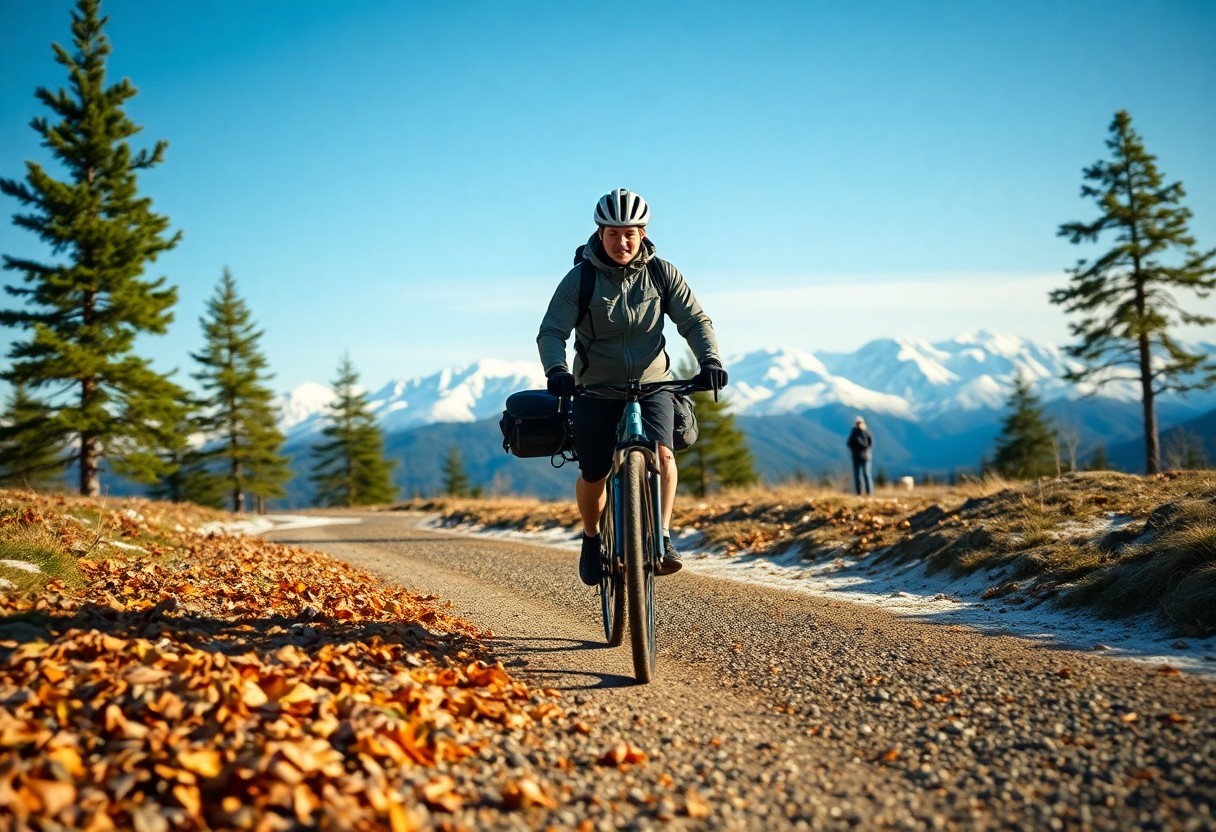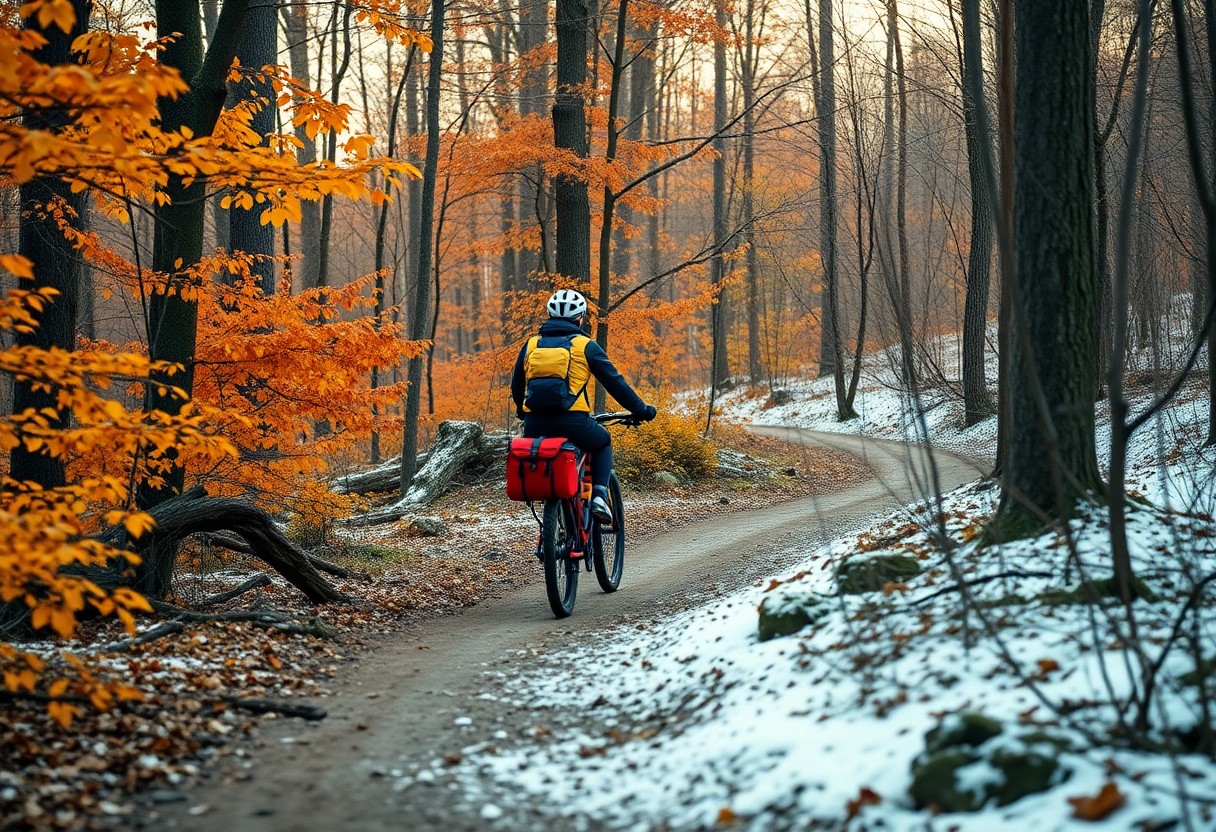Off-season bikepacking offers you an incredible opportunity to explore the beauty of nature in autumn and winter. As the landscape transforms, you’ll encounter fewer crowds and experience the serenity of quiet trails. However, it’s vital to prepare for challenging weather conditions, including cold temperatures and wet paths. Equip yourself adequately with proper gear and clothing to ensure a comfortable ride. Embracing the off-season can be rewarding, allowing you to witness stunning seasonal changes while enjoying your passion for cycling.
Resilient Rides: Gear Up for Cold Conditions
Embracing the chill of autumn and winter cycling requires a thoughtful approach to your gear. Invest in quality clothing and equipment specifically designed for the cold, ensuring comfort and safety on your rides. Choosing the right gear protects you from the elements and enriches your cycling experience, making those off-season adventures just as enjoyable as warmer months.
Essential Clothing: Layering for Warmth
Layering is the foundation of staying warm during your rides. Start with a moisture-wicking base layer to keep sweat at bay, followed by an insulating mid-layer for warmth, and finish with a windproof outer shell. Accessories like thermal gloves, wool socks, and a neck gaiter will help retain heat and shield you from chilly winds, ensuring you remain comfortable throughout your journey.
Bike Modifications for Winter Performance
Upgrading your bike for winter can significantly enhance performance, safety, and comfort. Fitting wider tyres with a lower pressure creates better grip on slippery surfaces, while installing a set of quality mudguards keeps you cleaner and drier. Consider also using a more robust chain and gears; winter can be tough on your bike’s components, so durability is key to maintaining smooth operation.
Pay close attention to your tyres, as they are your only contact with the ground. Opting for tyres that feature a more aggressive tread pattern or those specifically designed for winter conditions can vastly improve traction on wet or icy paths. A drop in pressure between 30-40 psi can yield increased surface contact, enhancing grip significantly. Plus, don’t overlook your lighting; with short daylight hours, high-quality, bright lights not only illuminate your path but also ensure that you’re visible to others. Adapting your bike ahead of the winter season will transform your rides and make you a more confident cyclist in challenging conditions.

Navigating the Changing Terrain
As autumn gives way to winter, the landscape undergoes a profound transformation that can significantly impact your bikepacking adventures. Adjusting your riding style and approach to different terrains becomes crucial. Along with seasonal variations in trails, you must be prepared for unexpected challenges that arise as conditions shift. Remaining vigilant and adaptable allows you to embrace the ride, no matter what the trails throw at you.
Weather Patterns: Autumn to Winter Transitions
The transition from autumn to winter is marked by fluctuating temperatures and unpredictable weather patterns. You may start your journey amidst the vibrant colours and crisp air of autumn, only to find yourself battling the first frost or unexpected snowfall. Keep an eye on local forecasts and be ready to alter your plans. Being aware of typical patterns in your chosen region can give you insights into the best times to set out.
Terrain Challenges: Handling Mud and Snow
With the arrival of winter, riding on mud and snow can quickly test your skills and equipment. Mud can cause your tyres to lose grip, while snow may obscure familiar pathways. Ensuring your bike features wider tyres with appropriate tread can significantly enhance traction as conditions change. In snowy conditions, avoiding hard braking and maintaining a steady pace can help prevent slipping.
When navigating challenging terrains, preparation is key. Consider equipping your bike with studded tyres designed for icy conditions, enhancing grip on slippery surfaces. If you encounter thick mud, a lightweight bike with a lower gear ratio can allow you to maintain momentum without getting bogged down. Additionally, carrying a small shovel or mat can be invaluable for clearing paths or providing traction for tyres when you find yourself stuck. By anticipating these challenges and preparing accordingly, you can ensure a smoother, more enjoyable riding experience throughout the off-season.
Routes Less Travelled: Discovering Off-Season Trails
The off-season can unveil some of the most enchanting trails that are often overlooked during peak times. Autumn and winter provide unique opportunities to explore picturesque landscapes, less crowded pathways, and stunning seasonal changes. Consider venturing into national parks, coastal routes, or charming countryside paths that burst with colour in the autumn and take on a serene stillness in winter. With rolling hills carpeted in crisp leaves or snow-blanketed tracks, each ride presents a different experience and a chance to connect with nature in its most vibrant and tranquil forms.
Popular Trails to Explore in Autumn
Autumn offers a delightful palette of colours along popular trails like the South Downs Way and Forest of Dean. The vibrant foliage creates a stunning backdrop for your rides, while crisp air invigorates your senses. With fewer cyclists on the trails, you can enjoy the peaceful surroundings and perhaps even spot local wildlife preparing for winter. The combination of scenic beauty and enjoyable temperatures makes these trails ideal for an autumn adventure.
Hidden Gems for Winter Bikepacking
For those seeking a more adventurous winter escape, trails such as the Borderlands Trail and Cairngorms National Park offer spectacular scenery and solitude. These less-trodden paths wind through snow-dusted landscapes, providing an exhilarating experience amidst stark beauty. You’ll find abandoned villages, frost-kissed trees, and serene lakes, creating a magical atmosphere that’s simply unmatched in the more popular summer months.
Exploring the Borderlands Trail during winter reveals a breathtaking tapestry of rugged countryside paired with tranquillity. The remnants of old military roads and forest tracks give a glimpse into the area’s history while the crisp air and panoramic views invigorate your spirit. Local pubs along the route can offer hearty warm meals, making your ride not only an adventure but a cultural experience as well. With snow under your tyres and the soft crunch of frost around you, winter bikepacking in these hidden gems is a journey worth taking.
Nutrition and Hydration Strategies
As the temperature drops and daylight fades, maintaining proper nutrition and hydration becomes vital to your off-season bikepacking success. Filling your body with the right nutrients keeps your energy levels high and your spirits up, enabling you to tackle those challenging trails. Incorporating a mix of carbohydrates, proteins, and healthy fats into your diet helps you build stamina and recover effectively after rides. Don’t overlook hydration, as the cooler air can disguise your body’s need for fluids, leading to dehydration if not managed carefully.
Fueling for Cold Weather Adventures
Choosing high-energy snacks is vital during colder months, as your body burns more calories to keep warm. Focus on nutrient-dense foods such as nuts, energy bars, and dried fruits that deliver quick energy boosts and are easy to pack. Hot meals will also provide comfort and warmth; consider carrying a compact stove to whip up a warming meal like instant oatmeal or soup mid-ride. Simple carbohydrates can fuel your immediate energy needs, while proteins aid in recovery after those long excursions.
Staying Hydrated: The Importance in Chilly Conditions
Dehydration can sneak up on you in cold weather, where you may not feel as thirsty as in the summer months. Your body still loses moisture through breathing and perspiration, particularly during physical exertion. Regularly sipping on fluids, even when you’re not feeling parched, is vital to avoid the negative effects of dehydration. Warm drinks, such as herbal tea or soup, can provide hydration while also keeping you warm.
Chilly conditions can trick your body into underestimating its hydration needs, as perspiration may not be as apparent. When you ride in the cold, consider that you’re still losing fluids through breath vapour. Aim to drink around two litres over the course of your ride, adjusting based on the length and intensity of your exertion. Sports drinks can also help replenish lost electrolytes, but listen to your body – if you’re feeling fatigued or dizzy, it’s time to refuel and rehydrate. Keep an eye on the colour of your urine; pale yellow indicates proper hydration, while darker tones mean it’s time to drink up.
Embracing Solitude: The Mental Benefits of Off-Season Bikepacking
Off-season bikepacking offers a unique opportunity to immerse yourself in solitude, allowing for deep mental rejuvenation. The quiet of autumn and winter rides can foster introspection, helping you disconnect from the chaos of daily life. As you pedal through serene landscapes, the rhythm of your bike synchronises with your thoughts, promoting mindfulness and clarity. This solitude not only enhances creativity but can also bolster emotional resilience, making it an crucial aspect of your journey.
Reflection and Connection with Nature
Your bikepacking adventures during the off-season grant you the chance to engage in meaningful reflection. Each ride becomes a dialogue with nature, where you can contemplate your experiences while being enveloped by the beauty of the changing seasons. Observing the transformation in the landscape enhances your connection to the natural world, making every turn of your pedals an exploration of both the environment and your own thoughts.
Overcoming Loneliness: Tips for Enjoying Your Own Company
Learning to embrace solitude during your rides can indeed be transformative. You can enjoy your own company by bringing along engaging podcasts or audiobooks, which can serve as companions on long stretches. Carrying a journal can also provide an outlet for your thoughts, allowing you to process your experiences. Finally, setting small goals along your route, like reaching a specific point by a certain time, can create a sense of achievement that enriches your journey. Perceiving solitude not as loneliness but as an opportunity for self-discovery can greatly enhance your bikepacking experience.
- Cultivating mindfulness through journaling and mental reflection
- Pairing your rides with audiobooks or podcasts for companionship
- Setting personal challenges to create a sense of purpose
Numerous strategies can help you relish your own company while out on the trails. Think of creating playlists of your favourite tunes to accompany your ride, which can lift your spirits and energise your sessions. Engaging your senses with nature’s beauty, from crisp leaves under your tyres to the sky’s palette of colours, can foster a profound connection to your surroundings. Don’t hesitate to pause and simply soak in the sights and sounds; this can enrich your experience immeasurably. Perceiving your time alone as an adventure will shift your mindset and make each ride more rewarding.
- Engaging your senses with the natural world fostered on your journey
- Creating themed playlists to uplift your rides and maintain energy
- Pausing often to reflect on your surroundings enhances mindfulness
Final Thoughts
Embracing off-season bikepacking not only allows you to explore the beauty of autumn and winter landscapes but also enhances your personal resilience and wellbeing. As the trails quiet down, you connect deeply with nature, fostering a sense of peace and reflection. Delving into the unique challenges of colder rides sharpens your skills and adaptability, preparing you for warmer seasons ahead. Staying diligent with your gear choices and nutrition practices during this time is imperative; investing in quality equipment ensures comfort and safety. Ultimately, each ride deepens your appreciation for the bikepacking experience, solidifying your commitment to adventure throughout the year.
